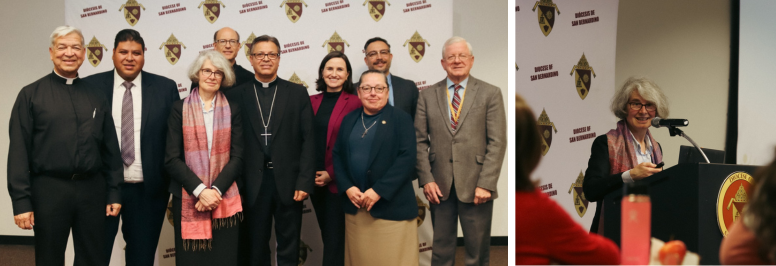When she spoke to the Diocese of San Bernardino on the Synod on Synodality two years ago from Rome it sounded to many like a new way of being Church. By the time Sister Nathalie Becquart, XMCJ, gave her second Synod talk to the Diocese on Feb. 20, this time in person, the focus was on the practical application of Synodality at the parish and even family level.
Sr. Nathalie is the Undersecretary of the Synod of Bishops, a groundbreaking distinction for a woman religious in the Church. She is currently travelling internationally to share her understanding of Synodality and to see how the Synod is taking root in different parts of the world.
“What I have seen, in each culture we have seeds of Synodality, and we have obstacles,” she said. “It’s a long path to cultivate these seeds.”
Sr. Nathalie gave her talk, entitled “How to cultivate a culture of Synodality at the diocesan and parish levels,” as part of a Synod Formation Day at the Diocesan Pastoral Center. It was also offered to parishes and Catholic schools of the Diocese via livestream.
Diocesan and parish employees first met Sr. Nathalie in February of 2022 when she gave the keynote address for the Combined Vicariate Meeting via livestream from Rome. At that time, the Synod on Synodality was in its first year and the task was to introduce the concept of Synodality. Parishes were in the midst of holding Synod listening sessions and the national and continental phases had yet to unfold.
At the Feb. 20 Formation Day it was acknowledged that some have struggled to understand how to put Synodality into practical application and others have not embraced it for fear that it subverts important Church traditions. Sr. Nathalie noted that the essentials of Synodality – sharing and listening to one another in dialogue, walking together in common mission – have been part of the Church from its earliest days. The best way to practice Synodality is simply to get started, she added.
“I don’t have a magic solution to give you,” Sr. Nathalie said. “It’s about learning by doing. It’s about practice.”
That includes practice at the family level. In her afternoon remarks, Sr. Nathalie connected well-known family interactions with Synodality. One example was the decision-making process a family follows when deciding where to go on vacation.
“The father can decide everything alone, without listening to his wife or the children. He can also really consult and listen and make a process where the whole family reaches a consensus on where to go. That’s the Synodal style,” she explained.
Maria Antonia Amao, Associate Director of the Department of Ministry Formation Institute (MFI) said putting Synodality in the family context was an eye-opening and important reminder.
“We need to start at home,” Amao said. “If we don’t experience [Synodality] with our family, how are we going to do it outside in the world?”
The Diocese of San Bernardino’s embracing of Synodality has compared favorably with many dioceses Sr. Nathalie has visited, she said, citing vibrancy and youthfulness that make the local Church more open to the work of the Holy Spirit.
In his closing remarks, Bishop Alberto Rojas echoed Sr. Nathalie’s comments that Synodality will take time and practice.
“I see it as an ideal, beautiful way of being Church,” he said. “It’s how Jesus started with the Apostles.”


